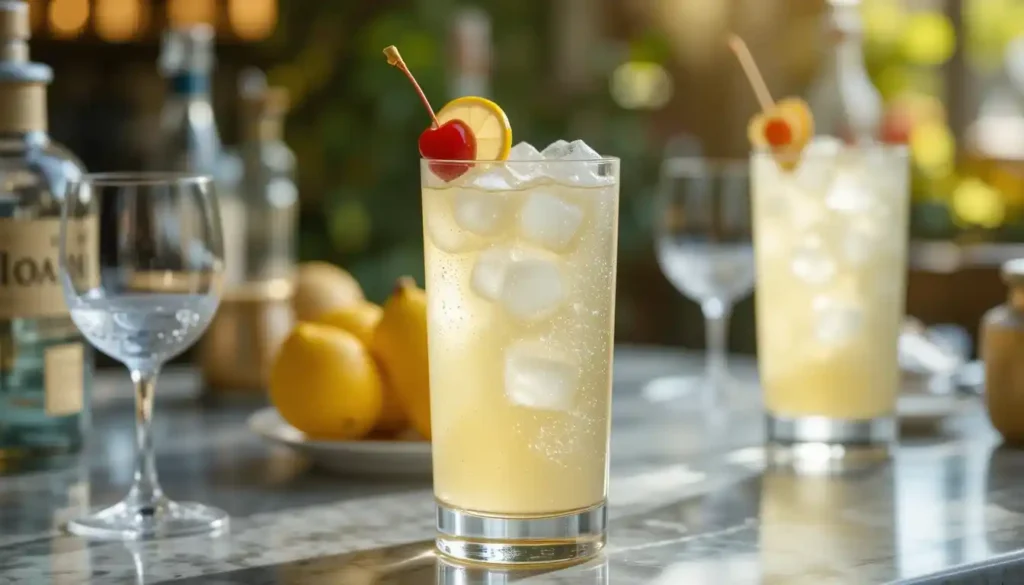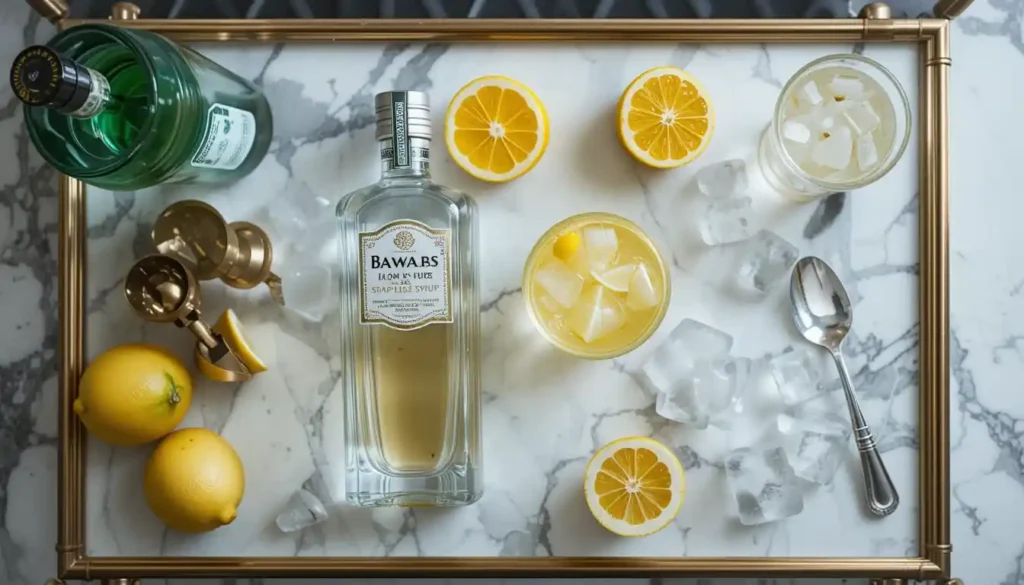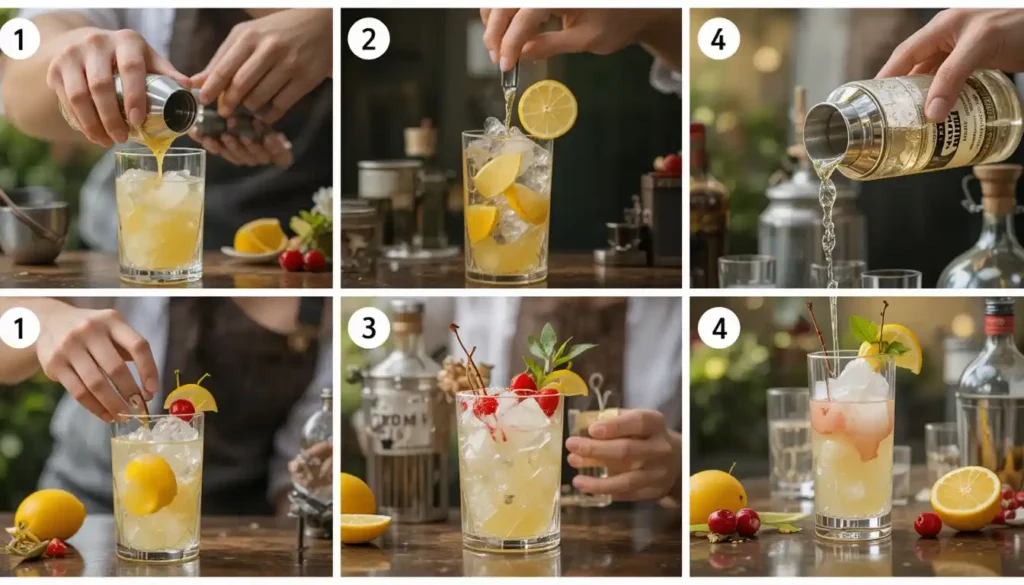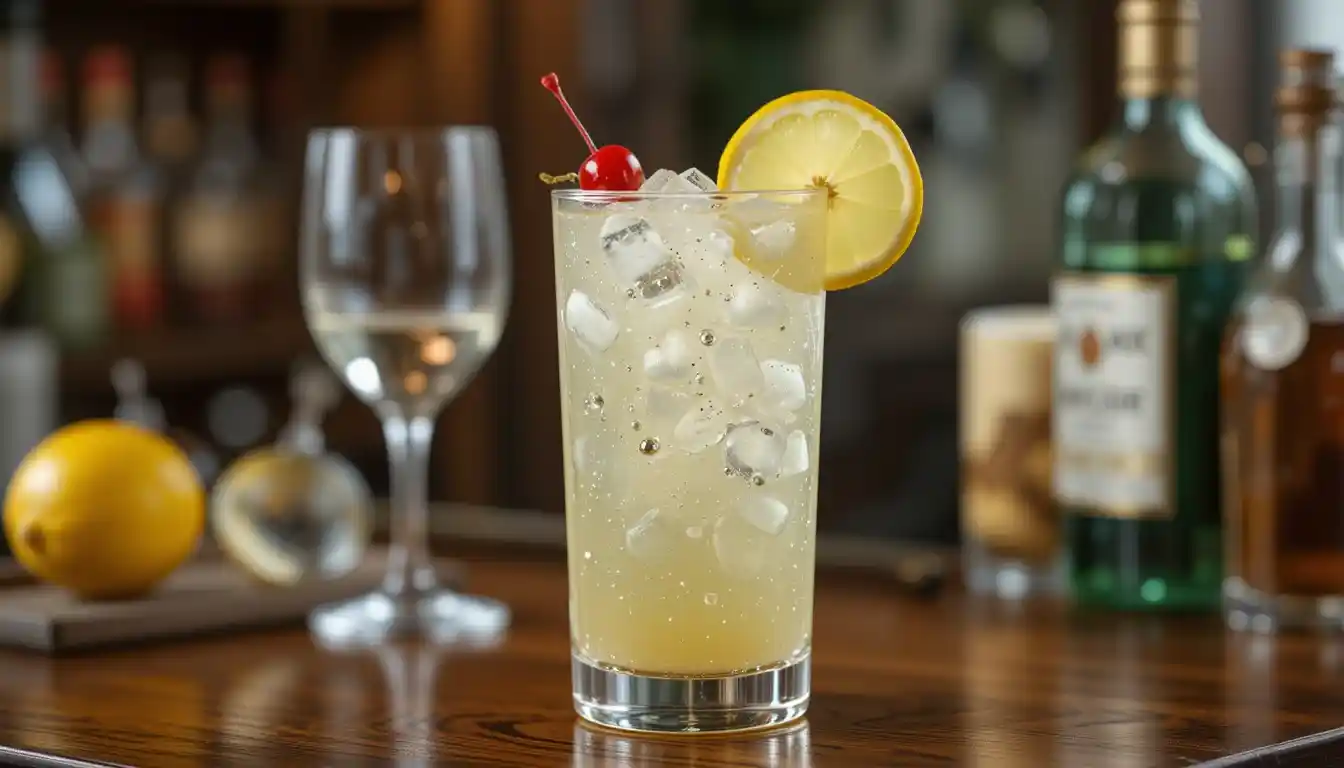Table of Contents
Did you know the classic gin sour cocktail in your hand likely evolved from a 19th-century prank? Originally called the “John Collins,” this fizzy drink became a bar staple after appearing in early cocktail manuals. Today, it’s celebrated as a perfectly balanced mix of dry gin, tart lemon juice, and sweet syrup – a grown-up lemonade that’s ideal for summer sipping.
The magic happens when botanical gin meets fresh citrus. A generous pour of soda water lightens the drink, while cracked ice keeps it frosty in a tall highball glass. This recipe’s simplicity makes it ideal for backyard gatherings or lazy afternoons – just four ingredients create a sophisticated yet approachable beverage.
We’ll explore the cocktail’s journey from historic taverns to modern bars, plus share pro tips for nailing the 2:1:1 ratio of spirits to citrus to sweetener. You’ll learn why using a cocktail shaker matters, how to pick the right gin, and creative twists like berry-infused syrups. Ready to mix up sunshine in a glass?

History and Origins of the Tom Collins
Behind every great drink lies a tale, and this fizzy favorite’s origin story bubbles with intrigue. What began as a tavern mystery in the 1800s became a blueprint for modern mixology, blending humor and craftsmanship in equal measure.
From John Collins to Tom Collins
The drink’s name changed faster than ice melts in summer. Early versions called it the “John Collins” after a London bartender, but American drinkers later swapped names like trading cards. By 1876, newspapers joked about a fictional “Tom Collins” character who supposedly insulted bar patrons – a viral hoax before memes existed.
Bartender Harry Johnson settled the debate in 1882. His manual standardized the 2:1:1 ratio of gin, lemon juice, and syrup we still use. The shift from Dutch genever to sweeter Old Tom gin (a precursor to London dry) gave the cocktail its signature smoothness.
Cultural Impact and Evolution of the Cocktail
This sparkling drink became the original influencer of the cocktail world. Its success paved the way for fizzy sours like the French 75, while the tall Collins glass became synonymous with refreshment. Prohibition-era drinkers even used it to mask bathtub gin’s harsh taste.
| Era | Base Spirit | Signature Twist |
|---|---|---|
| 1800s | Genever | Barrel-aged citrus |
| Early 1900s | Old Tom Gin | Maraschino cherry garnish |
| Modern Day | London Dry | Fresh lemon wheel |
Today’s versions honor history while embracing new trends. Craft bars might swap simple syrup for honey or infuse soda water with basil. Yet the core appeal remains: a perfectly balanced cocktail that’s survived trends, temperance movements, and TikTok.
Essential Ingredients and Tools
Crafting a memorable Tom Collins starts with quality components and the right gear. Every element plays a role in creating that crisp, refreshing sip that’s become a global favorite.

Selecting the Right Gin and Lemon
London dry gin offers juniper-forward botanicals that cut through the drink’s sweetness. For a historical twist, try Old Tom gin – its subtle honey notes pair beautifully with citrus. Avoid overly floral varieties that might overpower the lemon.
Fresh lemons are non-negotiable. Roll fruits on your counter before juicing to maximize yield. “Bottled lemon juice lacks the bright acidity that makes this cocktail sing,” notes NYC bartender Maria Reyes.
Preparing Simple Syrup and Setting Up Your Barware
Homemade simple syrup takes 5 minutes: combine equal parts sugar and hot water. For richer texture, use demerara sugar. Store it refrigerated for up to a month.
Essential tools include:
- A highball glass to showcase the drink’s effervescence
- Cocktail shaker for proper dilution
- Jigger for precise 2:1:1 measurements
- Bar spoon to gently mix ingredients
Always use fresh club soda – flat bubbly ruins the texture. Cracked ice melts slower, keeping your drink chilled without dilution. Garnish with a lemon wheel or maraschino cherry for visual flair.
Mastering the Tom Collins Cocktail Recipe
Creating this iconic drink requires equal parts precision and playfulness. While the formula seems straightforward, small adjustments transform good cocktails into bar-quality masterpieces worth savoring.

Step-by-Step Preparation
- Chill a 12-ounce Collins glass with ice water
- Combine 2 oz dry gin, 1 oz fresh lemon juice, and ½ oz simple syrup in a shaker
- Add ice cubes and shake vigorously for 12 seconds
- Strain into your glass filled with fresh cracked ice
- Top with 3 oz chilled club soda using a bar spoon
Shaking aerates the mixture, creating a silky texture. “The ice melt during shaking is crucial – it softens the gin’s bite,” explains Boston mixologist Lila Chen. Always use a metal shaker for faster cooling.
Mixing Techniques and Drink Balancing Tips
Struggling with sweetness? Add syrup in ¼ oz increments. For extra tartness, zest the lemon before juicing. If using Old Tom gin, reduce syrup by 25% to account for its natural sweetness.
Prefer a lighter body? Stir ingredients directly in the glass instead of shaking. This method creates fewer air bubbles, letting the botanical gin flavors shine brighter. Always measure with a jigger – free-pouring risks imbalanced sips.
| Ingredient | Adjustment | Flavor Impact |
|---|---|---|
| Lemon Juice | +½ oz | Brighter acidity |
| Simple Syrup | -¼ oz | Drier finish |
| Club Soda | Sparkling water swap | Subtle mineral notes |
Garnish with a lemon wheel speared with a luxardo cherry for professional flair. Serve immediately – the effervescence fades faster than summer sunsets.
Exploring Variations and Creative Twists
Unleash your inner alchemist by reimagining this iconic drink with unexpected ingredients. While the classic formula remains timeless, modern mixologists have crafted exciting updates that honor tradition while delivering fresh flavor adventures.
Honey-Sweetened and Herb-Infused Variations
Swap white sugar for honey syrup to amplify floral gin notes. Combine equal parts honey and hot water, then chill. For herbal twists, steep lavender or rosemary in warm syrup for 15 minutes before straining. These infusions add garden-fresh complexity without overpowering the citrus backbone.
Modern Twists with Cucumber or Champagne
Muddle 3 cucumber slices before shaking for a crisp, spa-like refreshment. Hendrick’s gin pairs perfectly with this veggie upgrade. Celebratory versions replace club soda with brut Champagne – reduce syrup by ¼ oz to balance the bubbly’s dryness.
| Variation | Key Ingredient | Flavor Profile |
|---|---|---|
| Southern Collins | Bourbon | Smoky & caramelized |
| Russian Spring | Vodka + Chambord | Berry-forward & crisp |
| Elderflower Spark | St-Germain | Floral & aromatic |
Always adjust ratios gradually. Start with ¾ oz syrup instead of 1 oz when using sweeter spirits. Garnish with edible flowers or herb sprigs for Instagram-worthy presentation. Remember: even wild experiments need balance – let your shaker be your laboratory!
Conclusion
The enduring charm of this gin-based drink lies in its perfect harmony of history and flavor. From its 19th-century tavern roots to modern backyard gatherings, the cocktail remains a refreshing staple thanks to three core elements: quality gin, fresh lemon juice, and balanced simple syrup.
Mastering the drink requires attention to detail. Always use a chilled highball glass and measure ingredients precisely with a jigger. The classic 2:1:1 ratio of spirits to citrus to sweetener ensures consistent results. For creative flair, try herb-infused syrups or swap club soda with Champagne.
Nutrition matters – a standard recipe contains about 180 calories, so enjoy mindfully. Garnish with a vibrant lemon wheel or plump maraschino cherry for visual appeal. Share your twists using seasonal fruits or artisanal gins.
Ready to mix? Grab your shaker, embrace the craft, and toast to summer’s favorite fizzy companion. Don’t forget to share your masterpiece – every sip tells a story!
FAQ
Can I make a Tom Collins without gin?
Yes! Swap gin with vodka for a “Vodka Collins” or try white rum for a tropical twist. Adjust the sweetness to match the spirit’s flavor.
What’s the difference between a Tom Collins and a John Collins?
The original John Collins used Holland gin (genever), while the modern version typically uses London dry gin. The name “Tom” Collins became popular in the late 1800s.
Is fresh lemon juice really necessary?
Freshly squeezed juice adds bright, zesty flavors that bottled versions can’t match. For the best results, use ripe lemons and strain out the pulp.
How do I balance the drink if it’s too tart or sweet?
Start with equal parts lemon juice and simple syrup, then tweak to taste. Add more syrup for sweetness or a splash of soda water to mellow tartness.
Can I prepare a non-alcoholic version?
Absolutely! Replace gin with non-alcoholic spirit alternatives or herbal tea. Add a dash of lemon bitters for complexity, and garnish as usual.
What’s the ideal glass for serving?
A tall Collins or highball glass works best. Fill it with ice to keep the drink chilled and dilute it slowly for a refreshing sip.
Can I use honey instead of simple syrup?
Yes! Mix honey with warm water to create a honey syrup. Use a 1:1 ratio, and adjust based on your preferred sweetness level.


1 thought on “Refreshing Tom Collins Cocktail Recipe”
Comments are closed.